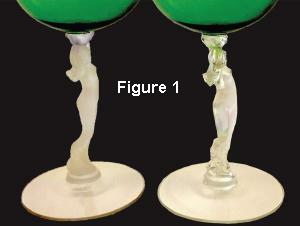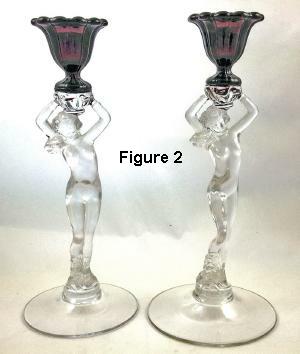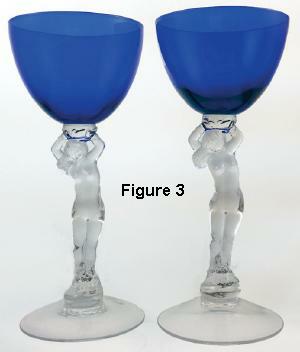Hand Made - What It means
by Dave Small
Issue No. 462 - October 2012
Cambridge glass was created in a factory using standard molds, jigs, and fixtures. Like any manufacturer, Cambridge strove to make their products consistent and of good quality. Despite the tools and fixtures, there was a lot of hand work involved. This human element did introduce variations in the products from time to time.
There were also factory seconds which were not always destroyed. It is thought that
 these may have found their way into the aftermarket via Cambridge employees. Overall, I think the quality control was pretty good. Most of the time we find the glassware to be consistent from piece to piece.
these may have found their way into the aftermarket via Cambridge employees. Overall, I think the quality control was pretty good. Most of the time we find the glassware to be consistent from piece to piece.
However, I do have a few examples to illustrate how inconsistencies do appear from time to time. Figure 1 shows two ivy ball vase nude stems side by side. The two ladies are facing in the same direction. Notice that the body of the girl on the right is twisted. Her stomach turns toward the camera. This was a case of the hot glass twisting a bit as it came out of the mold. Similarly, you will find that the heads of the Cambridge Swans aren't always aligned and positioned in the exact same way. The swan came out of the mold with a straight neck and had to be repositioned by hand while the glass was hot.
Figure 2 shows a pair of 3011 Amethyst Statuesque Candlesticks. As you can see, the one on the right has a much larger foot and is a bit taller. The two pieces are the same distance from the camera. So how did this happen? The nudes are made in three pieces. The bowls are blown into molds and the stems are pressed so they should be pretty consistent in size. However, the feet weren't molded. They were free formed by hand. What we're seeing here is an
 unusually large variation in the diameters and elevation of the feet. They were probably made at different times by different workers. When later brought together as a pair, they didn't match
up so well. Of course, it is also possible that the diameter of the smaller foot might have been reduced with a repair to remove a rim chip. However, I don't believe that would have accounted for this much difference. The smaller foot is relatively flat whereas the larger foot is significantly elevated (hollowed out).
unusually large variation in the diameters and elevation of the feet. They were probably made at different times by different workers. When later brought together as a pair, they didn't match
up so well. Of course, it is also possible that the diameter of the smaller foot might have been reduced with a repair to remove a rim chip. However, I don't believe that would have accounted for this much difference. The smaller foot is relatively flat whereas the larger foot is significantly elevated (hollowed out).
Page 110, Plate 57 of Colors in Cambridge shows an amethyst nude claret with a bowl as it came out of the mold (hasn't yet been cut off). Stemware like this could be 'height adjusted' when cutting off the bowl. For example, I checked my collection of nude cocktails and found a considerable variation in bowl height. The glass with an elevated (hollowed out) foot had a shorter bowl than one with a relatively flat foot. This is how they adjusted for foot differences to end up with glasses that are close to the same overall height. Of course, they didn't have this option with pieces with the candlestick, cigarette box, or cupped comport where cutting off part of the top would have ruined the piece.
Figure 3 shows two Royal Blue 3011 cocktails. They are approximately the same overall height. Notice that the glass on the left has a relatively flat foot and the bowl has
 considerably more height. The glass on the right has an elevated foot so the workers had to cut off more of the bowl to equalize the overall height. If you see a height difference in stemware, it could also be that a glass was repaired. The rim of a drinking vessel might have been ground down to remove a rim chip. As with the candlestick example, the height difference could also have been caused by a difference in thickness or elevation in the handmade feet.
considerably more height. The glass on the right has an elevated foot so the workers had to cut off more of the bowl to equalize the overall height. If you see a height difference in stemware, it could also be that a glass was repaired. The rim of a drinking vessel might have been ground down to remove a rim chip. As with the candlestick example, the height difference could also have been caused by a difference in thickness or elevation in the handmade feet.
I believe Cambridge stemware measurements were more consistent in the later periods than in the early days as the company gained experience in manufacturing and quality control. However, that may not have been the case during the reopen period because of a sudden influx of new employees and the economic pressures of a failing business.
Cambridge did do a little glass repair work when appropriate. For example, you can find pieces with a bit of grinding on the bottom of the foot (to level or stabilize). I've only seen this on larger pieces like the nude flared and cupped comports, and not very often.
